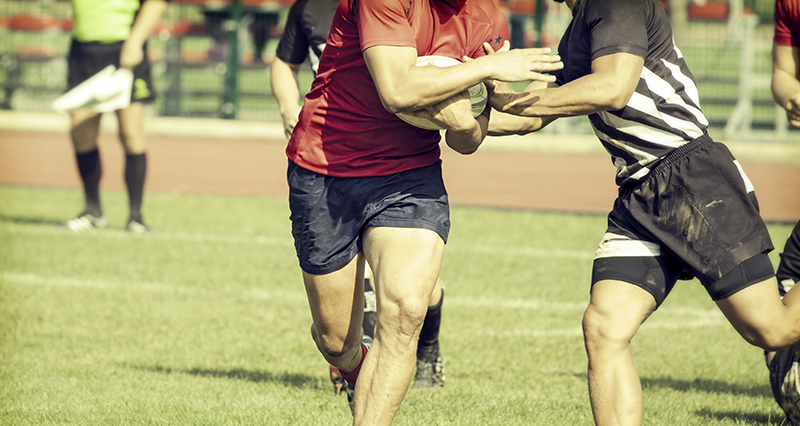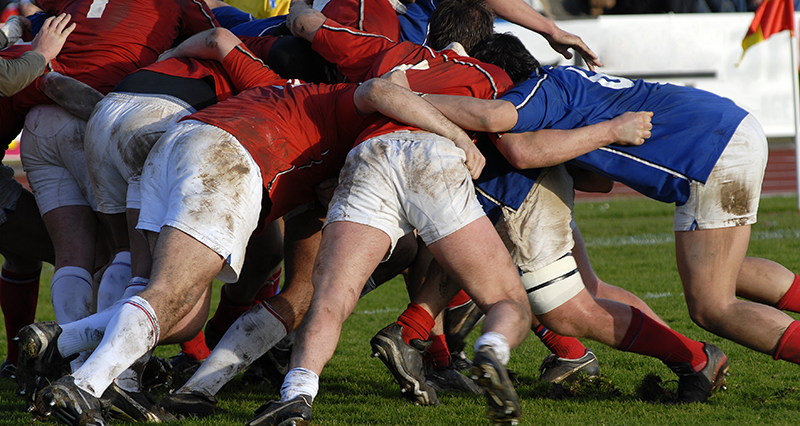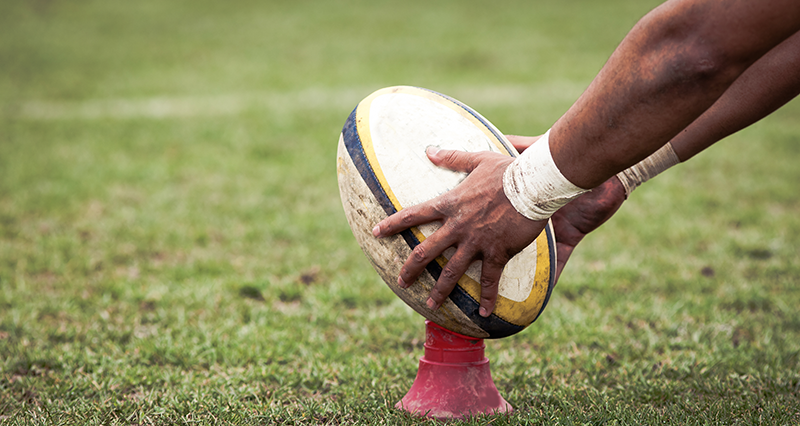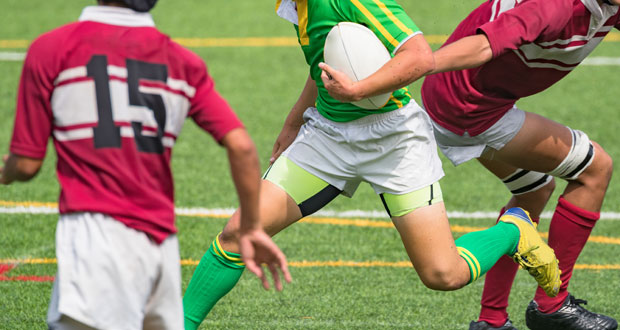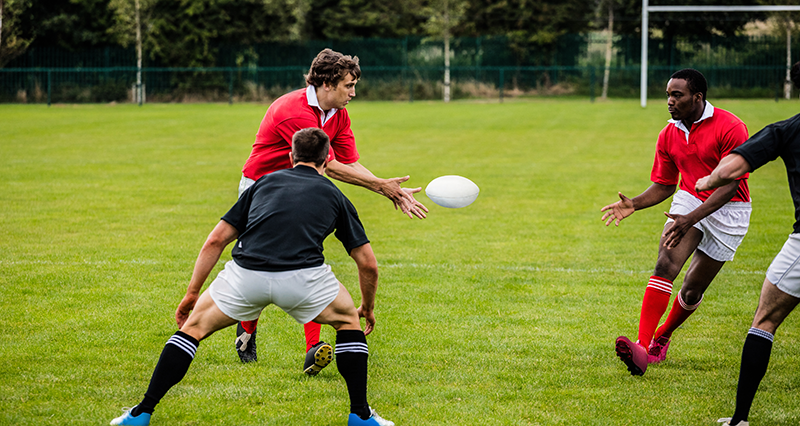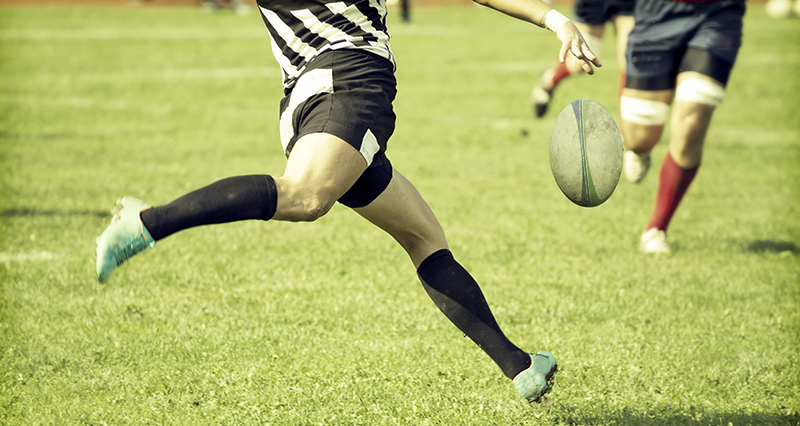Rugby is a tough, competitive contact sport that involves players tackling each other head-on and using their full force to move the opposition. Contact occurs in scrums and rucks, as well as tackles on a player running with the ball.
All of these actions can cause injury, with some being severe. A report has shown that over a 10-year period, 79 cases of spinal injury were reported as a result of rugby. Of these 79, 70% resulted in paralysis to the individual.
Prevention
Protective clothing
Rugby players never used to wear much in the way of protective equipment, but over recent years the use of items such as scrum caps, shoulder pads, mouth guards and shin pads has all increased. These all help to reduce the rate of minor to moderate injuries.
Warm-up
Warm-ups are important in rugby, as in all sports. Gradually increasing the body temperature, heart rate and circulation can help to reduce injuries by improving the elasticity of muscles and tendons, improving motor performance, as well as initiating responses from the bodies positional sensors, such as muscle spindles and Golgi tendon organs. Warm-ups should consist of a minimum of 10 minutes of cardiovascular work (such as light jogging or cycling), followed by active stretches and skill-related drills.
Training
As with all sports, the athlete must be fit for the game at hand. This includes cardiovascular fitness, which will enable your heart, lungs and circulatory system to provide enough oxygen to the working muscles to maintain a high level of work for long periods. You must also possess the muscle strength and endurance required to produce repeated contractions over this same period. All of this should be achieved through regular training, which is specific to the sport. Pre-season conditioning is also important, as research has shown that more injuries occur in the first part of a season, indicating that players are not fit enough following an off-season break.
Injuries
The highest rates of injuries in rugby are to the lower limb, especially the knee and ankle. Head and neck injuries are then followed closely by shoulder injuries. 70% of injuries are muscular or ligamentous. A concussion is also a very common rugby injury in both adults and children. Visit our sister site Sportsinjuryclinic.net for more information on concussions.
Sprained ankle
A sprained ankle is one of the most common injuries in rugby, other sports, and day-to-day life. A sprain is a tear or complete rupture of a ligament, and in the case of the ankle, the most commonly injured ligament is the anterior talofibular ligament. This ligament lies on the outside of the joint and is injured when the player rolls the ankle so that the sole of the foot faces inwards. Find out more about sprained ankles.
Medial ligament sprain
The medial collateral ligament of the knee is commonly injured in rugby due to tackles coming from the side. This force coming from the outside of the body stretches and often tears the medial ligament on the inside of the knee. Ligament sprains are graded from 1-3 with 3 being a complete rupture of the ligament. Learn more about medial ligament sprains.
Cartilage injuries
Damage to the cartilage within the knee joint occurs most often due to a twisting force being applied to the knee when the foot is firmly planted on the ground. The cartilage which is damaged is in the form of two rings which sit on top of the shin bone (tibia), within the knee joint, one medially and one laterally. Find out more about cartilage injuries.
Hamstring strains
A hamstring strain, or pulled hamstring, is a common injury across all sports. The usual mechanism of a hamstring injury is during a short burst of speed when running. The hamstrings are placed under most strain whilst they act to decelerate the forward movement of the lower leg. Learn more about hamstring strains.
Hamstring strains
A contusion occurs as a result of a direct impact on a muscle, most commonly the thigh muscles. This compresses the muscle against the underlying bone causing muscular damage and bleeding. This is sometimes also known as a dead leg due to the feeling it can produce. There will usually be extensive bruising. Find out more about contusions.
Shoulder dislocation
Shoulder dislocations occur when the arm is forced into an abducted (to the side) and rotated position. This can happen in a tackle, or if a player falls onto an outstretched hand. All shoulder dislocations should be reduced (‘popped back in’) as soon as possible, but only by a medical professional and usually following an x-ray to check for other associated injuries. The arm should then be immobilised for a short period. Learn more about shoulder dislocations.
AC joint separation
This is another common shoulder injury, which occurs most regularly from falling or receiving a blow directly onto the point of the shoulder. The injury is due to tears of the acromioclavicular ligament and possibly also the coracoclavicular ligament, in more severe cases. The most obvious symptom is a step deformity, where the clavicle is raised, producing a bony lump on top of the shoulder. Find out more about AC joint separations.

